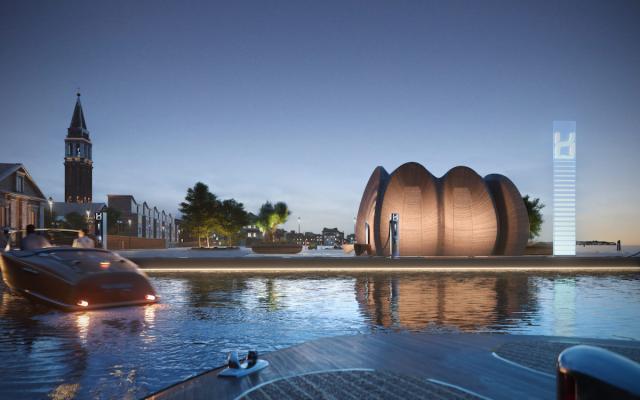DROPSPIKE
2021 - Film & Video (Film & Video)
8:00 minutes
Leticia Ramos
Leticia Ramos’s film DROPSPIKE is the second of a five-part film project entitled STORIES OF THE END OF THE WORLD . Each film in the series takes place in a different part of the world where climate change modifies the landscape. The short 16mm film was mostly shot during Ramos’s residency at La Bacque in Switzerland. The science fiction movie is set in 2044 when large glowing spheres inexplicably appear in different landscapes of the globe, one of them on the gelid coast of Pyramiden, a former Russian mining town on the Norwegian archipelago of Svalbard, in the High Arctic, and totally abandoned in 1998. Ramos visited the uncanny location in 2012, and it is not until Drop Spike that some of the images she captured there have found their place in her practice. In DROPSPIKE , as the shining orb breaks the monotony of the scenery, a robotic voice announces that the sphere is a sign that the ice has melted. Announcing the end of time, the voice claims: “If you see a large sphere, you are in danger”. A peculiar characteristic of the apocalyptic sphere is that it can only be perceived in person, by the naked eye, it cannot be documented through photography, film, or mapping technology. The film’s grainy texture and montage aesthetic creates a sense of dilated time. Celluloid film and emulsion are the artist’s primary materials, which allow her to manipulate the perception of time in the film. Its open-ended narrative generates an unsettling feeling that is difficult to classify, something between the melancholic realization of humanity’s imminent end and the renewal of a link with an occult being that cannot be rationalized.
Trained as a filmmaker, Leticia Ramos has cultivated a specific interest in the procedures and evolution of photography and film techniques since the beginning of her career in the early 2000s. Her research-based projects explore the material, historical and conceptual aspects of image-making and how it shapes and interferes with our perception of reality. Like an empiricist scientist, for each project, Ramos develops all kinds of contraptions and image capturing machines that assist her in generating imagery and building narratives that go beyond what an existing camera or a given cinematographic lexicon can achieve. From experimental film emulsions to homemade pinhole cameras to microfilming and x-rays machines, Ramos’s prototypical devices and made-up methods are often the bridge between ancient and invented stories, scientific experiments, natural and sociopolitical events. More recently, she has devoted her research to environment and climate disasters, always drawing on speculative fabulation, mysticism, and science-fiction as points of both departure and arrival.
Colors:
Related works sharing similar palette

© » ART & OBJECT
Art & Object Marketplace: A New Way to Buy Art Online | Art & Object Skip to main content Subscribe to our free e-letter! Webform Your Email Address Role Art Collector/Enthusiast Artist Art World Professional Academic Country USA Afghanistan Albania Algeria American Samoa Andorra Angola Anguilla Antarctica Antigua & Barbuda Argentina Armenia Aruba Ascension Island Australia Austria Azerbaijan Bahamas Bahrain Bangladesh Barbados Belarus Belgium Belize Benin Bermuda Bhutan Bolivia Bosnia & Herzegovina Botswana Bouvet Island Brazil British Indian Ocean Territory British Virgin Islands Brunei Bulgaria Burkina Faso Burundi Cambodia Cameroon Canada Canary Islands Cape Verde Caribbean Netherlands Cayman Islands Central African Republic Ceuta & Melilla Chad Chile China Christmas Island Clipperton Island Cocos (Keeling) Islands Colombia Comoros Congo - Brazzaville Congo - Kinshasa Cook Islands Costa Rica Croatia Cuba Curaçao Cyprus Czechia Côte d’Ivoire Denmark Diego Garcia Djibouti Dominica Dominican Republic Ecuador Egypt El Salvador Equatorial Guinea Eritrea Estonia Eswatini Ethiopia Falkland Islands Faroe Islands Fiji Finland France French Guiana French Polynesia French Southern Territories Gabon Gambia Georgia Germany Ghana Gibraltar Greece Greenland Grenada Guadeloupe Guam Guatemala Guernsey Guinea Guinea-Bissau Guyana Haiti Heard & McDonald Islands Honduras Hong Kong SAR China Hungary Iceland India Indonesia Iran Iraq Ireland Isle of Man Israel Italy Jamaica Japan Jersey Jordan Kazakhstan Kenya Kiribati Kosovo Kuwait Kyrgyzstan Laos Latvia Lebanon Lesotho Liberia Libya Liechtenstein Lithuania Luxembourg Macao SAR China Madagascar Malawi Malaysia Maldives Mali Malta Marshall Islands Martinique Mauritania Mauritius Mayotte Mexico Micronesia Moldova Monaco Mongolia Montenegro Montserrat Morocco Mozambique Myanmar (Burma) Namibia Nauru Nepal Netherlands Netherlands Antilles New Caledonia New Zealand Nicaragua Niger Nigeria Niue Norfolk Island Northern Mariana Islands North Korea North Macedonia Norway Oman Outlying Oceania Pakistan Palau Palestinian Territories Panama Papua New Guinea Paraguay Peru Philippines Pitcairn Islands Poland Portugal Puerto Rico Qatar Romania Russia Rwanda Réunion Samoa San Marino Saudi Arabia Senegal Serbia Seychelles Sierra Leone Singapore Sint Maarten Slovakia Slovenia Solomon Islands Somalia South Africa South Georgia & South Sandwich Islands South Korea South Sudan Spain Sri Lanka St...

© » KADIST
Joshua Serafin
2022Through the language of dance and choreography, Void by Joshua Serafin narrates the creation of a new God, the birth of a futuristic deity...

© » ARTS EQUATOR
Weekly Picks: Singapore (30 July - 5 August 2018) | ArtsEquator Thinking and Talking about Arts and Culture in Southeast Asia Singapore July 30, 2018 How To Be Happy (again) by Ethos Books 5 Aug 2018 As part of Esplanade’s Spoken Word Sunday series, How To Be Happy (again) will start the series off this sunday! It will be an evening of rhyme and rhythm filled with words exploring happiness and the notion of a greater good...

© » KADIST
Pratchaya Phinthong
2022Pratchaya Phinthong’s work has explored the mineral and karmic economies of Laos, a country that shares language, beliefs, and a long border with his own native region of Isaan (Northeast Thailand)...

© » SLASH PARIS
Resilient Currents: On Communal Re-Existence — Forma — Exhibition — Slash Paris Login Newsletter Twitter Facebook Resilient Currents: On Communal Re-Existence — Forma — Exhibition — Slash Paris English Français Home Events Artists Venues Magazine Videos Back Previous Next Resilient Currents: On Communal Re-Existence Exhibition Mixed media Upcoming Seba Calfuqueo, Miroir d’eau (capture d’écran), 2023 Courtesy de l’artiste Resilient Currents: On Communal Re-Existence In about 1 month: March 21 → April 25, 2024 In anticipation of La Collective, its future creation and solidarity center, Thanks for Nothing presents its first international exhibition, which focuses on socially engaged practices related to Central and South America...

© » KADIST
Carolina Caycedo
2013In this two-channel video installation, Spaniards Named Her Magdalena, But Natives Called Her Yuma , Carolina Caycedo gathered footage during numerous research trips to dam sites in the Harz Mountains, Saxony, Westphalia and the Black Forest in Germany interspersed with images of the Rio Magdalena region in Colombia...

© » KADIST
Arash Fayez
2021The short film I Can Only Dance to One Song by Arash Fayez features a series of people from the migrant community in Barcelona singing along or dancing to songs of their choosing...

© » KADIST
Jonas Van and Juno B
2021Jonas Van and Juno B’s video work Kebranto is anchored by the figure of Boitatá, a snake that is part of the imaginary Guaraní communities that live between the current nation-states of Argentina, Brazil, Paraguay, and Uruguay...

© » ART & OBJECT
Zaha Hadid Architects Unveil Hydrogen Refueling Station, and More News | Art & Object Skip to main content Subscribe to our free e-letter! Webform Your Email Address Role Art Collector/Enthusiast Artist Art World Professional Academic Country USA Afghanistan Albania Algeria American Samoa Andorra Angola Anguilla Antarctica Antigua & Barbuda Argentina Armenia Aruba Ascension Island Australia Austria Azerbaijan Bahamas Bahrain Bangladesh Barbados Belarus Belgium Belize Benin Bermuda Bhutan Bolivia Bosnia & Herzegovina Botswana Bouvet Island Brazil British Indian Ocean Territory British Virgin Islands Brunei Bulgaria Burkina Faso Burundi Cambodia Cameroon Canada Canary Islands Cape Verde Caribbean Netherlands Cayman Islands Central African Republic Ceuta & Melilla Chad Chile China Christmas Island Clipperton Island Cocos (Keeling) Islands Colombia Comoros Congo - Brazzaville Congo - Kinshasa Cook Islands Costa Rica Croatia Cuba Curaçao Cyprus Czechia Côte d’Ivoire Denmark Diego Garcia Djibouti Dominica Dominican Republic Ecuador Egypt El Salvador Equatorial Guinea Eritrea Estonia Eswatini Ethiopia Falkland Islands Faroe Islands Fiji Finland France French Guiana French Polynesia French Southern Territories Gabon Gambia Georgia Germany Ghana Gibraltar Greece Greenland Grenada Guadeloupe Guam Guatemala Guernsey Guinea Guinea-Bissau Guyana Haiti Heard & McDonald Islands Honduras Hong Kong SAR China Hungary Iceland India Indonesia Iran Iraq Ireland Isle of Man Israel Italy Jamaica Japan Jersey Jordan Kazakhstan Kenya Kiribati Kosovo Kuwait Kyrgyzstan Laos Latvia Lebanon Lesotho Liberia Libya Liechtenstein Lithuania Luxembourg Macao SAR China Madagascar Malawi Malaysia Maldives Mali Malta Marshall Islands Martinique Mauritania Mauritius Mayotte Mexico Micronesia Moldova Monaco Mongolia Montenegro Montserrat Morocco Mozambique Myanmar (Burma) Namibia Nauru Nepal Netherlands Netherlands Antilles New Caledonia New Zealand Nicaragua Niger Nigeria Niue Norfolk Island Northern Mariana Islands North Korea North Macedonia Norway Oman Outlying Oceania Pakistan Palau Palestinian Territories Panama Papua New Guinea Paraguay Peru Philippines Pitcairn Islands Poland Portugal Puerto Rico Qatar Romania Russia Rwanda Réunion Samoa San Marino Saudi Arabia Senegal Serbia Seychelles Sierra Leone Singapore Sint Maarten Slovakia Slovenia Solomon Islands Somalia South Africa South Georgia & South Sandwich Islands South Korea South Sudan Spain Sri Lanka St...

© » KADIST
Miljohn Ruperto
2009Miljohn Ruperto’s silent video work Appearance of Isabel Rosario Cooper is an archive of ghosts...

© » KADIST
Participants include American Artist (artist); Anti-Eviction Mapping Project (data-visualization, data analysis, and storytelling collective); Jérôme Bel (choreographer); James Bridle (writer, artist, and technologist); Kate Crawford (Distinguished Research Professor at NYU); Martha Kenney (Assistant Professor of Women and Gender Studies at San Francisco State University); Laura Kurgan (Professor of Architecture at GSAPP, and Director, Center for Spatial Research, Columbia University); Trevor Paglen (artist and researcher); Gala Porras-Kim (artist); Kameelah Janan Rasheed (artist and learner); Steve Rowell (artist); Davide-Christelle Sanvee (performance artist); and Andros Zins-Browne (choreographer)...

© » ARTS EQUATOR
SEE WHAT SEE: BOYS' LOVE (BL) DRAMAS | ArtsEquator Thinking and Talking about Arts and Culture in Southeast Asia ArtsEquator Viewpoints November 13, 2021 By Lainie Yeoh I grew up in an era where queer films were rare exceptions and it was your holy gay-af duty to watch all the ones you could access...








